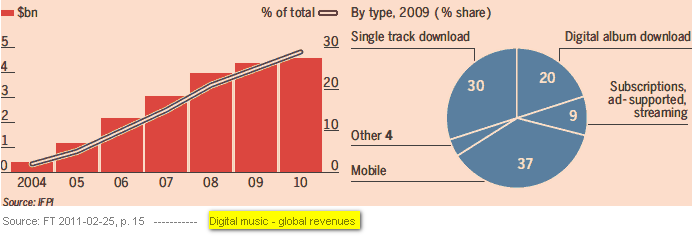When Apple launched its iTunes store in 2003, it was the only legal, simple option for downloading music. The story of the platform’s stellar success is best told by the numbers:
- – over 10 billion songs sold,
– expanded to include films, TV and books,
– 160 million credit card accounts on file,
– 30 percent commission on all newspaper subscriptions,
– refuses to share app customer information, and
– requires that subscriptions offered within an app be the same or better than those offered elsewhere.
- Article source – 2011 trends: Will iPad2 be Apple’s downfall?
UK retailer Tesco and some US retailers are pushing to minimize music labels’ up-front charges from £7 or £8 for a typical album to just 50 pence. This could help reverse a global trend of stores devoting decreasing or no shelf space to selling CDs, which have more than halved since 2000. But as the chart shows, sales of digital tracks continue to increase and Apple accounts for a large share of that revenue.
- Does Apple dominate everything?
No; it does not dominate the world’s smart phone market – it only accounts for 16 percent (25% in the US – January 2011 data). Nevertheless, it accounts for 75 percent of all tablet sales.
However, new entrants are emerging in the smart phone, tablet computer, and digital publishing markets, often using Android as the platform of choice, which already has a bigger installed user base. In fact, sales of Android devices are twice as high as Apple’s iPhone, proving that Google’s mobile software push, meant to guarantee it maintains its reach through search and advertising, is working for now.
Apple may continue plans to introduce an iPhone SIM (Subscriber Identity Module) card in some markets with their next generation. After all, the company is known for forcing telecom providers into revenue-sharing deals in exchange for short-term iPhone exclusivity after its release.
Subscribe yourself to get our next post first via e-mail right here:
- Will the Apple ecosystem survive?
Apple charges a 30 percent fee for selling digital content through its platform, while Google will retain only 10 percent and give companies more control over subscriber data. Plus, targeted advertising through Google offers even more potential revenue – an impossibility with Apple.
The iPad2 smart cover is a smart move on Apple’s part and once again proves that achieving great usability does not necessarily require a/b testing or focus groups. Instead, you have to be inventive, take a risk and keep it simple, stupid (KISS).
Making it look good AND useful is a winning combination (see 4 strategies to leverage usability tests the Steve Jobs way):

More to the point, Steve Jobs’ performance at the iPad2 unveiling was VERY impressive (short and to-the-point), and no doubt about it, the iPad2 offers many nice features in an attractive package:
- – learning new operating skills is unnecessary (e.g., connecting Apple TV is a cinch), AND
– making it a nice ornament for anyone’s desk or coffee table.

- So, will iPad2 precipitate the demise of Apple?
Peter F. Drucker’s The Essential Drucker (paperback – August 24, 2007, p. 14) neatly puts these things into perspective, by stating that selling
- “… still starts out with “our products.” It still looks for “our market.” True marketing starts out the way Sears starts out – with the consumer, his demographics, his realities, his needs, his values. It does not ask, What do we want to sell? It asks, What does the customer want to buy? It does not say, This is what our product or service does. It says, These are the satisfactions the customer looks for, values, and needs.
Indeed, selling and marketing are antithetical rather than synonymous or even complementary.”
Apple understands this very well: the success of its stores in China is in large part due to the fact that they are the country’s only reliable source for Apple products. Shoddy customer service and smack-downs like Antenna-gate do not change the fact that the company focuses on customer needs when readying products for market.
Publishers’ willingness to give up their right to special offers on channels other than Apple’s (e.g., special homepage offers for students must also be sold through Apple), suggests they have not learned much from the iTunes experience.
That should have taught them that accepting Apple’s terms now will cost them years to extract even small concessions in the future. Worst is that iTunes did not stop music revenues from getting halved.
To illustrate, instead of Random House accepting Apple’s terms and including its 17,000 digital titles in the iBookstore, it and others might be better off holding back. Backing Android for a while may well be worth the risk, while simultaneously giving content providers an opportunity for achieve a healthier bottom line.
This may be equally advantageous for consumers if they are not already locked into the Apple family. But make no mistake, today’s consumer prefers a gadget with sleek design and great usability over a more affordable product. Yes, they will worry and complain to consumer groups about higher fees and less choice, but for now they just want a sleek iPad2 to play with.
- QUESTIONS – please leave a comment:
1. Which pay platform do you think will be the biggest by 2012 – Apple or Google?
2. Have you ever camped out in front of an Apple store to be first in line?
3. How likely is Apple to run afoul of regulators?
By the way, has there ever been something on an Apple product you did not like? Yeah, right!
PS. Please we ask you for your help: ComMetrics is hiring software talent

Pingback: CyTRAP
Pingback: Urs E. Gattiker
Pingback: MyComMetrics
Pingback: Chris Isaac
Pingback: World Economic Forum
Pingback: MyComMetrics
Pingback: PRASANNAN.N
Pingback: Urs E. Gattiker
Pingback: CyTRAP
Pingback: MyComMetrics
Pingback: Urs E. Gattiker
Pingback: Naijand Inc